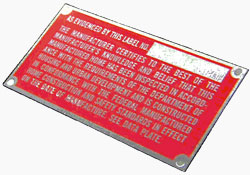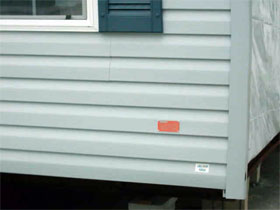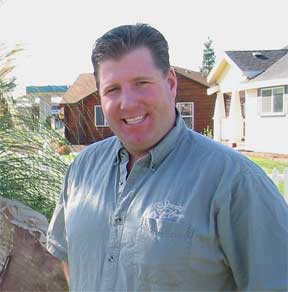News & Notes Archive - January 2008
Important words about the HUD label on a manufactured home: don’t lose that label–getting a loan or insurance may depend on it
Every now and then I get a call from someone asking how to tell if the previously owned home they’re considering is a manufactured home (i.e. HUD-code) or a modular home, or perhaps a so-called park model home. My answer: “Look for the red metal (aluminum) label, 2 by 4 inches in size, affixed to the lower exterior corner of each of the home’s transportable sections. For example, a double wide (two-section) home would have two HUD labels. They look like this:

This certification label, commonly known as the “HUD Label” is permanently affixed to all transportable sections of homes built to HUD standards after June 15, 1975. (Image courtesy of Institute for Building Technology & Safety)

The label is located close to the bottom of the exterior corner of the rear end of each transportable section (the front end being where the towing hitch was/is located). HUD labels are sometimes inadvertently removed during painting or re-siding, or even installation. (Image courtesy of ITBS)
This label is proof positive that this is a HUD home (and only a HUD home). HUD labels are designed to be permanently attached to their sections, and for good reason. They are proof of the home’s identity (including when and where constructed) and they certify it was built to exacting HUD standards.
As important, evidence of HUD labels, and their unique ID numbers, are almost always demanded by lenders, insurance underwriters, local governments and manufactured home communities as a condition for getting a loan approval, a policy, or the okay to put the home in a MH park.
If your home is new, be sure to note the location of the HUD label(s) and protect them going forward. Don’t paint over them. If you cover them–while adding steps, siding or a porch, for example–make sure you can still easily access them for viewing by an inspector (by removing a board or face plate, for example).
HUD will not replace lost or missing labels. But if the label is missing (not uncommon with older HUD homes), all is not lost. A non-governmental entity, the Institute for Building Technology & Safety (IBTS), under contract to HUD, has been keeping track of all those certification labels since 1976, keeping tabs on their histories, the homes on which specific labels have been affixed, and the first destinations of those homes.
In response to repeated requests from homeowners, lenders and other interested parties, IBTS now offers a fee-based label verification service. You can now go to www.ibts.org and click on Label Verification. The page is http://www.ibts.org/label_req.htm
For a $50 fee (to offset the cost of research and the issuance of a verification letter) you can get a fast answer, usually within two business days. The Institute’s Richard St. Onge claims “at most, we’re unable to identify five percent of the homes we’re asked about–they’re either pre-HUD, park models, or modular homes.”
For more about the Institute, please see my interview with Richard in my October 2007 News & Notes.
Interview: 15 minutes with...Matthew Jaeger
Note: In my role as an industry observer and consumer advocate I speak with people at all levels of the manufactured home industry (MH) to gain insights I share with my readers to help them be better informed. Some I have interviewed for a one-page column that runs in an industry trade publication. In return the magazine runs an ad for the Grissim Guides. No money changes hands. I insist on this. Aside from book sales, I neither solicit nor accept a dime from the industry, and my readers have my assurance I intend to keep it that way. Here’s this month’s interview:

Matthew Jaeger, GM and partner, Serenity Homes of Chico, California
Who: General manager and partner, Serenity Homes, Chico, California
Background: Age 38. Born and raised in Yuba City, CA. After high school there, attended Chico State College (1988-1994), earning a B.S. degree in Construction Management (“I’m a third generation general contractor, and I knew early on this was what I wanted to do”). In ’94, started working for Jaeger Construction (“founded by my grandfather and at that point managed by my father”), a general engineering contractor: site grading, subdivision development, road construction, utility placements–“We developed properties for homes to be built on.” In ’99, Jaeger’s father, William Jaeger, who owned property in nearby Oroville that he wanted to develop, partnered with Serenity Homes, which sold Fuqua HUD homes exclusively, to sell homes into what would be a gated subdivision.
In 2005, after six years of faltering progress to fill the subdivision’s 119 lots, William Jaeger bought Serenity Homes and recruited his son Matt Jaeger as the new GM and partner. In the two years since, Matt Jaeger repositioned Serenity Homes from a sales only dealership into a full-service builder, providing all site preparation, installation and warranty service with each home sold. Serenity offers many floor plans in either HUD, modular or site-built. Jaeger met his wife Kristina in ’97. The couple married in ’99. They have two boys, Ryan, age seven, and Jeffrey, four.
- Q: Did you know much about HUD code homes before your father invited you to manage Serenity Homes?
- A: I knew nothing about MH, at the time (laughs). Seriously, at that time Jaeger Construction had grown to a $23 million a year company with over 75 employees. I was an on-site foreman and an office supervisor in charge of building project management and estimates.
- Q: What was his strategy in hiring you?
- A: Serenity’s problem was they could sell well–Fuqua is a really fine home–but their customer service ended when the sale closed. They couldn’t finish the job. They exercised no control over the sub-contractors, who routinely did a poor job of set-up and installation (often never finishing), often leaving homebuyers very disappointed. Fuqua used to cringe every time Serenity would call, because it meant sending crews down from Oregon to fix problems, which chewed up their profits. I’d been trained by a large construction company on the proper procedures, and the first thing I said when I walked in was, We’re going to start our own construction company and there are three things we’re going to emphasize: safety, quality and production–and not one is front of the other. In short, we’re going to run Serenity as a builder, not as a dealership.
- Q: How did you go about doing it?
- A: We started interviewing local carpenters, with or without contractor’s licenses. Went through about 125 interviews over several months. Out of those we hired 60 to try them out, and out of those we kept about 23 for full time work.
- Q: That had to be a huge salary bite.
- A: It was, but it took a crew that size to catch up. When I started in 05, we had 43 unfinished jobs–that included incompletes and new construction. In 06 I had it down to 25 jobs. This year we started out with 12, currently we’re up to 17, all new construction. As we caught up we reduced our staff. On the sales side, I took it a step further, making sure every sales rep had a thorough knowledge of home construction, unlike the previous sales staff. Currently my three sales people are all contractors, who can sell. Two have their GC license and the third is a lead carpenter. So when customers ask detailed questions about joists and decking and R values and what are the differences between features, they get knowledgeable answers, and that gets them very excited.
- Q: I take it Fuqua Homes has been pleased with the turnaround?
- A: You bet. We’ve got a great rapport with them. We don’t have to wait on them for a lot of warranty service items. We get a purchase order over the phone, go out and fix it. Our bill backs are always legitimate. If you maintain a good relationship with your builder, that’s worth its weight in gold.
- Q: The California MH market is very tough right now. How are you faring?
- A: This has been an awful year for everybody. But with our business model, we can get by selling half the homes of a regular dealership because we have the additional revenue stream from doing the construction. Plus, if homes aren’t selling, we’ll bid other work. We’ll go out and build a garage, a deck, a remodel, anything. Income from that construction carries the sales lot.
- Q: How would you characterize your clientele?
- A: People who are on the border of going site-built or high-end manufactured home–‘tweeners, we call them. Many are empty nesters looking to downsize. It’s a higher end niche. We don’t do homes in parks. We’re not set up for that. It’s all individual parcels or into our development. Our focus when customers walk in is on building relationships. Absolutely no pressure–I can tell a customer who’s been somewhere else because they come in looking scared to death. They’ve already been completely hassled. I will never ask a customer when they walk in, Do you have property?”
- Q: What’s your take on the MH industry’s short term prospects?
- A: I look for housing in general to come back, a conservative rebound. Interest rates are still low, and the Fed is doing what it can. The lending will be stricter, more conservative. And manufactured housing should be a part of that. But expect things to be generally stagnant until after 2008. It’s an election year and historically the markets are stagnant, or even down. It doesn’t matter whether or Republican or Democrat wins. It seems to be a subliminal thing. As for Serenity, my firm belief is that a company that does great things and has a satisfied customer base will continue to prosper. A good customer reference always puts you in first place as a qualified bidder, even if someone else has the same house at less cost.